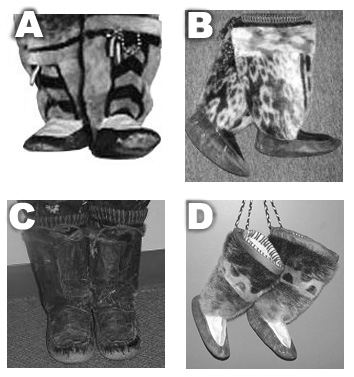 Image source: Kativik School Board
Image source: Kativik School Board Four
pairs of sealskin kamiks:
A) Mens' with
haired legs, bleached tongues, and black soles.
B) Mens' with haired legs and
all black feet.
C) Childrens' black legs and feet.
D) Womens' with haired
legs, bleached tongues, and black soles. |
| |
There
are three kinds of sealskin used to make kamiks:
1. Haired sealskin or
seal fur is used for kamik legs and is especially suited for the winter because
it is warmer than hairless sealskin. It also stays more flexible in the cold.
Kamiks with haired legs are especially popular for children and Elders It
is very important to remove all excess fat on haired sealskin otherwise the hair
will turn an ugly yellow. Fat is removed by rubbing the skin into sand. In the
winter, the skin can also be firmly ground into the snow and then beaten with
a stick after the fat has hardened. Washing in soap and water also works well
to remove excess fat. The other two kinds of sealskin have the hair removed.
Some hairless sealskin is black and some is bleached yellowish-white. 2.
Black sealskins are made by shaving the hair off of the thin outer skin called
epidermis. This type of sealskin is the most waterproof and is used to make the
foot sections of kamiks. It also used for the legs in boots that will be worn
in very damp conditions. 3. Bleached sealskin is not quite as waterproof
as black sealskin because the epidermis is removed along with the hair. There
are three methods of bleaching sealskins. The first method is to soak the skin
in hot water to loosen the hair and epidermis, which is then scraped off. If the
water is too hot it will cook the skin, but if it is too cool it will not loosen
the hair. The second method is to roll the fresh sealskin up with the hair inward
and leave it in a warm place until the hair slips off easily. The third method,
involves soaking the skin in a tub of seal fat until the hair slips off. This
method makes the most waterproof skins. |




